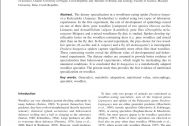Rok
2007Autoři
RNDr. Milan Řezáč, Ph.D.prof. Mgr. Stanislav Pekár, Ph.D.
Druhy
Dysdera hungarica Kulczyński, 1897 ESObsah
The dietary specialization in a woodlouse-eating spider Dysdera hungarica Kulczyñski (Araneae: Dysderidae) is studied using two types of laboratory experiments. In the first experiment, the rate of development of spiderlings reared on one of three diets: pure woodlice [composed of two species Oniscus asellus Linnaeus and Armadillidium vulgare (Latreille)], pure flies (Drosophila melanogaster Meigen), and a mixed woodlouse-fly diet, is studied. Spiders develop significantly faster on the woodlice-containing diets (i.e. pure woodlice and mixed diet) than on the fly diet. In the second experiment, the prey-choice for two woodlice species (O. asellus and A. vulgare) and a fly (D. melanogaster) is investigated. Dysdera hungarica spiders capture significantly more often flies than woodlice. These contrasting results reveal the different value of developmental and behavioural experiments. The dietary studies are assumed to provide better evidence of specialization than behavioural experiments, which might be misleading due to unnatural conditions. It is concluded that Dysdera hungarica is a metabolically adapted woodlice specialist. The present study thus provides the first evidence of nutritional specialization on woodlice.



